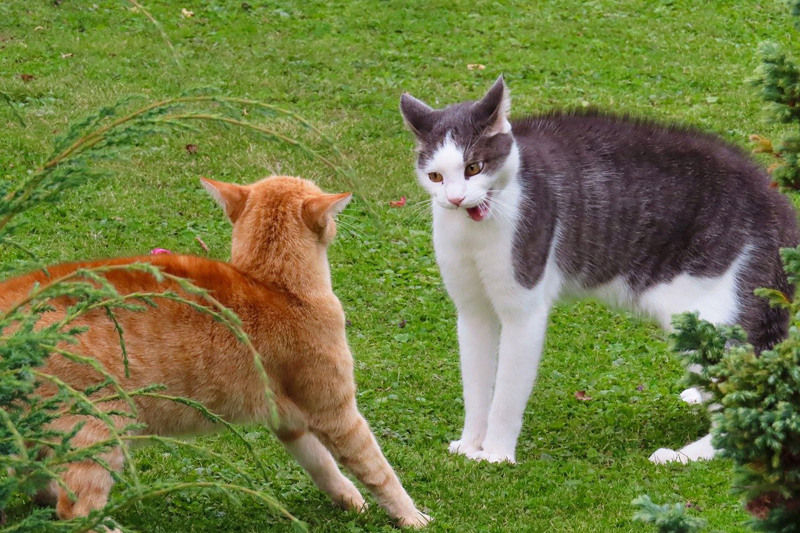This post may contain affiliate links. This means I may receive a small commission if products are purchased through them. All opinions are honest and remain my own.
If you’re wondering how to keep stray cats out of your yard or garden, I totally get it. Even though I love cats, I understand unwanted visits from strays or neighborhood cats can be a nuisance.
When we moved into a new neighborhood a few years ago, my cat Charlie went nuts with the neighborhood cats roaming around. It was so bad he was spraying near the windows and front door, something which he never did at our old house.

Though they may seem innocent, free roaming cats in your yard can cause a number of issues:
- If you have cats in your home, stray cats wandering into your yard can cause a lot of territorial issues. You may notice your cat spraying, excessively meowing, or scratching.
- Cats can use your flower or garden beds as a litter box, which can ruin them by excessive digging and also contaminate edible plants
- Odors from cats urinating around your home to mark territory
- Loud noises from cat fights
- They can kill birds and other wildlife on your property
After researching this topic a bit more in-depth, I discovered there are so many ways you can try to keep neighborhood cats away from your backyard.
But not all these methods will work for everyone, as it just depends on where you live and the particular cats you’re trying to keep out. Cats, just like humans, are individuals. What may work for some cats won’t work for all of them.
Let’s explore some of these options a bit more so you can understand what they are, how they work, and if you think it might be worth trying.
Methods to keep cats out of your backyard, garden areas, and flower beds
Chicken wire
Using chicken wire is an effective solution at keeping cats out of specific areas like vegetable gardens or flower beds, or anywhere else there’s fresh exposed soil.
You simply lay it down across the dirt and secure it with garden stakes. This will prevent them from being able to dig in the dirt, which will deter them from hanging around.
The downside of this technique is you have to plan ahead of time and do it before or immediately after you plant. The wiring will not effect how the plants grow.
Alternatively, if you’re preparing garden beds you can build chicken wire fences or cages to keep them out entirely. This will keep out other animals like deer and rabbits as well.
Scat mats
Scat mats are plastic mats with spikes used to discourage cats from entering certain areas. Don’t worry though, they are plastic and won’t puncture their paws (or your foot if you step on it). They work because they’re uncomfortable and cats don’t like to walk across them.

You can place them around the perimeter of vegetable gardens or flower beds, or any other place you don’t want them entering. They’re also thin and easy to cut, so you can customize them to fit other areas.
The downside is these mats are not visually appealing at all.
Rock landscaping or mulching
While landscaping with rocks or mulch won’t physically prevent cats from entering an area, it will stop them from using it as a litter box. In turn, this could make them prefer to hang in more enticing areas (like away from your house) with more easily accessible dirt or sand.
The good thing about this solution is it’s not an eye sore, and can add to the visual appeal of your home.
Ultrasonic devices
There’s an extensive market of ultrasonic devices sold to keep pests and critters out of your yard. These claim to work on cats as well. These things emit bursts of low frequency noise that’s undetectable to humans, but can be heard by cats. The theory is they will stay away because the noise scares them.
However the truth is these things seem to be fairly unreliable and come with mixed reviews. Some say they work great, others find they don’t work at all. This probably comes down to the individual cat(s) and how triggered they are by the machine.
If you want to try one of these things, place them next to points you want to discourage cats from entering the most such as your flower beds or veggie garden. You also may need to move the device around from time to time so the cats don’t get used to it and just learn to avoid it.
It also may be a good idea to use them in conjunction with other methods.

You can find ultrasonic machines like this CLEANRTH model at Amazon.
Keep cats away by scent
Keeping cats away by scent is not a foolproof method by any means. The effectiveness varies depending on the particular cat, as not every cat may be put off by each of these smells.
Nevertheless, here are some scents that are said to deter cats:
- Citrus
- Citronella
- Lavender
- Rosemary
- Banana
- Cinnamon
- Vinegar
You can try growing lavender or rosemary around the perimeter of your yard where the cats may be entering.
Another method some say is highly effective is sprinkling lemon or orange peels around flowerbeds, as many cats are turned off by the strong scent of citrus.
Commercial outdoor cat repellents
They also have commercially made spray products on the market that are supposed to keep cats away. One of the most popular is this Cat Mace cat repellent spray. It uses a diluted mix of peppermint, citronella, and lemongrass oils as these scents are known to deter cats.

Even though peppermint oils are said to be toxic to cats, using diluted amounts and spraying outdoors to try and keep them away is not harmful. Never use pure citrus oils (or other essential oils) directly on or around your cats.
DIY cat repellent recipes
Another option is to make your own cat repellent spray. Mix ingredients together in a spray bottle. Then, simply spritz it around the perimeter of your yard, or anywhere else you want to keep cats away from. It’s pretty simple and probably uses ingredients you already have around the house.
Rosemary, lemon, and vinegar cat repellent spray
- White vinegar
- Lemon juice
- Rosemary (fresh or dried)
All of these ingredients are cat repellents, so ratios aren’t super important. You can use a 50/50 mix of vinegar to lemon, or use mostly one or the other. If you don’t have rosemary, you can leave it out. However combining all three will make it the strongest.
Orange oil cat repellent spray
- 8-10 drops orange oil concentrate
- 8 oz water
For this second recipe, ratios are more important because the orange oil needs to be diluted properly. Orange (and other citrus) oils are incredibly potent and aren’t good to use around cats on their own.
For these sprays to be most effective, you’d need to spray the area often and especially after it rains. If it doesn’t work to keep cats out of your garden, at least you won’t have wasted a ton of money.
Warning about using essential oils as cat repellents
You may come across many homemade cat deterrent sprays that use essential oils. Even the commercially produced Cat Mace spray includes peppermint and lemon oils.
When they’re highly diluted with water and sprayed outdoors around perimeters of areas you want to keep cats away from, they’re generally fine. Just don’t spray them ON cats.
Essential oils in their pure form are extremely potent. Never use them directly on cats or in passive diffusers in your home with cats around.
According to Pet Poison Helpline, cats are very sensitive to phenols/phenolic compounds found in certain essential oils. In addition, they lack an enzyme in their liver to properly metabolize these oils.
Symptoms of essential oil poisoning in cats include:
- Vomiting
- Drooling
- Tremors
- Wobbliness
- Respiratory distress
- Low body temperature
- Low heart rate
- Liver failure
Read more: What Smells Do Cats Hate?
Do mothballs keep cats away?
Mothballs are commonly recommended as a way to keep cats out of your yard or garden. However moth balls contain pesticides and are toxic to not only cats, but also dogs and young children. If a curious cat ingests a mothball, it could get very sick. In addition, if you’re trying to plan to keep cats out of a vegetable garden, you definitely don’t want to use them around plants you plan to eat.
What about fencing to keep cats out?
Cat proof fencing may seem like the best solution to the problem of stray cats entering your yard, but it’s not always a practical choice.
The thing about cats is that they’re excellent escape artists. They are able to jump over or climb most fencing, as well as dig underneath. In order to have an entirely cat proof fence, you’d need to install one in which they were unable to do any of these things.
This could prove extremely difficult even if it’s said to be a “cat proof” solution (also incredibly expensive).
Not to mention, most of the DIY cat proof fencing I’ve seen ends up looking like a prison yard. And even then, often time cats are still able to find ways through.
The best idea I’ve come across that doesn’t look like a total eye sore is installing roller bars like this Oscilloot system.
However some say they have cats that can figure out how to get past these eventually!
Also check out: Cat Proofing Ideas for a Happier Life

Stray cats have been ruining my plants for as long as I can remember, and I’ve just had enough. So I will now use these methods to wave them away, and hopefully, they won’t be coming around this often now.